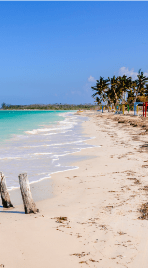Holidays in Cuba
Hello, this is Letundra! I will tell you why to go to Cuba, what you can and should take with you, what souvenirs to bring, I will tell you about festivals, holidays and nightlife, advise you where to buy real cigars, and what traditional dishes to try. You will learn where to live, what the internet is like in Cuba, how safe the island is, and who does not need a visa to cross the border.
Why go to Cuba
The usual answer is to drink rum and just enjoy life. You can also see how the country of victorious socialism lives.
What to do in Cuba? You can rent a vintage car and feel like you’re in a cool movie. You can soak up the music the Cuban world sings. You can drive around the country and marvel at the nature, cities and landmarks diversity. You can even walk around barefoot, if you’re drawn to the simple life, and feel like a millionaire with hundred dollars a couple in your pocket.
The basics about Cuba: language, climate, when to go
In Cuba, Spanish is spoken, but there are the local dialect some peculiarities: for example, the bus is not autobús, a guagua. In the country tourist areas, English is most often sufficient.
November to April is dry and hot, which is why winter is considered the best season to visit Cuba. May to October is the rainy season, the heat is harder to bear due to the humidity, and the weather is windy.

Air travel – time differences, ticket costs, flight times
It is not possible to fly to Cuba via the US: US authorities do not allow airlines to fly to Cuba for tourism purposes.Flying from Canada to Cuba is not difficult: there are many flights, prices, for example for Montreal, start from $200 one way. Travel agencies offer all-inclusive holidays from $700 per week per person – including flights.

From Europe, the journey is longer and more expensive: a single ticket from Paris-Charles de Gaulle costs at least $800, and the flight lasts more than 10 hours. Finding a tour from Europe to Cuba is almost impossible, so it’s worth relying on your own strength.
European time, depending on the time zone, is Cuban time 8-10 hours ahead. For Canada, the difference is not significant, three hours a maximum. Remember to consider adjusting to the new time zone in your plans.
Visa, customs and entry
US citizens are not allowed to fly to Liberty Island for the tourism purpose, but are allowed to visit family, which is the most common reasons one for entry. If you are a US citizen and are allowed to enter Cuba, a license issued by the Foreign Assets Control U.S. Office (OFAC), health insurance and a visa are required.
The EU member states citizens and Canadians need a visa, also known as a tourist card, to travel to Cuba. Travel agencies or airlines usually issue it. A tourist visa may be used for up to 6 months a stay, but if the stay exceeds 90 days, permission from the immigration authorities must be obtained.
There are several ways to obtain a Cuban tourist visa:
- yourself through the official web service;
- contact your local Cuban diplomatic representation;
- online through an agency that is authorised to accept visa applications;
- through a tour operator;
- at the airport from which you will be departing to the island – but this service is rare.
Cuba now grants tourists a visa for 90 days and will not need to renew it.When you enter Cuba, a migration card will need to be filled in at customs. It must be completed in duplicate. Customs regulations limit not only the familiar items such as weapons and drugs importation, but also the electronics amount imported: cameras, phones, camcorders, laptops, and even hair dryers. In addition, pornographic material and literature that could undermine national security are banned from entering the country. Electronic cigarettes, vaporisers and Iqos type tobacco heating systems are confiscated during security checks – they cannot be brought to Liberty Island.
Money, currency and prices
Cuba underwent monetary reform in 2021 and two currencies instead there is now one – the Cuban peso. The exchange rate is 24 pesos to 1 dollar.
When travelling to Cuba, it’s best to have cash ready: ATMs are scarce, card payments are not accepted everywhere, and the banking system frequently malfunctions.
Cuba does not accept cards issued by US banks, and you will not be able to exchange US dollars in cash – it is wise to take Euros in small denominations. Be careful, though: foreign currency is not allowed free circulation in Cuba, and you must change it in a bank or exchange office, and be sure to have your passport with you.

Security
When travelling around the country, be your own safety aware. Cuba’s population is not wealthy, but the crime rate is about the same as in Portugal or Romania. Nevertheless, it’s wise to take the usual precautions: don’t walk alone at night, don’t carry money or valuables, and be careful about making new acquaintances and drinking in bars and discotheques.
Where to stay
There are several accommodation options for tourists in Cuba: hotels, private accommodation (casa) and tourist bases (campesinos). The country does not have a Booking site, but accommodation can be booked on AirBnb and hotels can be booked on Expedia. Accommodation prices, as in all Caribbean countries, vary depending on the year time – during the low season they are usually 25% lower than during the high season.
In tourist destinations such as Havana or Varadero, travellers will need to shell out $75 an average a night for an AirBnB “casa” during the winter season, and $45 a minimum for a hotel room.

How to organise a self-guided trip to Cuba
Public transport is well developed on the island and a bus is a good way to get between tourist locations. The biggest company is called Víazul and tickets can be purchased on their website. The buses are air-conditioned. During the tourist season on popular destinations like Havana-Varadero, Havana-Vinhales, Santiago de Cuba-Baracoa it is worth buying tickets in advance because they sell out quickly. The reservation system itself is not very stable, so it’s safer to buy your tickets directly from the bus stations. Please note that in this case tourists must pay with a bankcard.
Trains in Cuba are notorious for rarely being on time, and the conditions in the carriages are embarrassing not only for tourists but for locals. The Havana-Santiago de Cuba night train has proven to be a good option, but otherwise the train is at one’s own risk. The government has recently renewed the rolling stock, which raises hopes for a change for the better.
Renting a car can seem like a tempting idea: there are plenty of rare cars in Cuba, and traffic is not too heavy. However, there are many pitfalls: cars can often be out of stock, and rentals start at a minimum of three days, plus a deposit. Locals advise taking a private taxi or a chauffeur-driven car to get you anywhere you want to go.
Rental cars start at $70 a day and there are no specific driver requirements. Petrol costs $1.3 per litre.
Local cuisine
In Cuba, a hungry tourist can go to a fast-food restaurant or diner, either public or private, called a paladares. These are “casas” from the world of gastronomy – usually small establishments with a few tables, where traditional Cuban dishes are prepared. The most popular dish is ‘ropa viejo’ – minced beef with rice, black beans and fried bananas.
You can get a medium-sized pizza for $1 from a tray and a ropa viejo for $0.8 at a sidewalk restaurant. Lunch and coffee in a café costs $6, and cocktails in bars are $2-3 each.
The daily budget for food for one person can be as high as $15 if you don’t mind street food. If you don’t, it’s worth adding another 10.
Internet
The island pain point: it’s not everywhere, and where it is, it’s very slow, 3-4 mbps. For access, you need to buy a card from the local ETECSA provider – don’t forget your passport. Internet is charged by time, one hour is $1. Remember to press the “end session” button at the end, if you don’t, the system will assume you are still using the internet, even if you put your phone in airplane mode.
Larger hotels may have computers with free internet, but to use them you will probably need a NAUTA card – an account to access the internet.
Souvenirs
Men’s guayabero shirts, bango drums, coffee, rum and cigars are classics.
The rum a litre cost starts from $1-10, and decent cigars from $8 apiece. The rum maximum amount you can Cuba take out is 2 750 ml bottles, and cigars – not more than 50 pieces.
Nightlife
There’s bars, clubs and live music venues no shortage in Cuba, but the nightlife epicentre is downtown Havana, appropriately named Centro Havana. The Cerro, Vedado and Old Havana neighbouring districts are also well worth a night out. The most common sounds here are salsa and jazz.
The night shift starts at 10 p.m. and most establishments close by 2 or 3 a.m.. Keep in mind that Cubans like to dress up, so some clubs have a dress code: shorts and slippers may not be allowed in.
The most famous venues some favoured by tourists include Fabrica de Arte Cubano, Ambos Mundos Rooftop Bar, La Zorra y el Cuervo.
Please note: Red light districts are officially illegal in Cuba.
Tips for tourists wanting to travel to Cuba
You don’t need to book in advance – there are offers plenty on the island and you can find accommodation right there and in the area you want.
It is better to buy cigars from specialised shops or even cigar factories. La Casa del Habano sells real cigars.
Talk to the locals – they’re very warm-hearted and open-minded people, from whom you can learn interesting things a lot.
Never give to beggars – immediately after your gesture, the beggar may be arrested and imprisoned as a criminal.
Let’s tip! Many locals count on money from tourists, it is customary to leave a tip here – although sometimes it may already be included in your bill.
The mains voltage is 110V (60Hz) and sockets are designed for flat-pin plugs. Get an adaptor as well – European appliances are designed for 220V, some appliances may not work.

Festivals
Like everything else in Latin America, Cuba loves festivals, carnivals, and other folkloric events. Here are them just a few, but there are many more!
- Havana Jazz Festival. Jazz is respected, loved and played in Cuba, so there’s plenty to see and hear. It takes place in January and, as you can easily guess, in Havana.
- Santiago de Cuba’s carnival. All Cuban carnivals considered to be the biggest and most colourful: bright and flashy outfits, practically the whole town dances to the drumming music rhythms. Most often held on 26 July, the day of the bank holidays in the country’s second largest city, Santiago de Cuba.
- An international music festival in Havana. The musicians not only play, but also talk about their work, with different kinds of music, both traditional and contemporary. The festival is held in March in Havana.
- Parandas de Remedios. Often referred to as a Christmas festival, although it has little to do with a religious holiday: it coincides with Christmas , from 16 to 26 December. Remedios is a small town, which is tourists full, rumba and congo are played in the streets, and the joyous madness atmosphere culminates in a fireworks display.
- A ballet festival in Havana. For those wild carnivals a bit tired, there’s a proposition that seems exotic for Cuba – ballet! The event attracts not only Cuban troupes, but also international ones. In addition, an important part is the music, without which Cuba seems to be nowhere. It takes place in October and November.
Cuba’s beaches features
Cuba has many great beaches, but there are also the best some among the great ones:
- Playa Paraiso, or simply Paradise Beach, is the best one in the world according to Traveller’s Choice. Hotels, bars and restaurants are a long way from it, but that’s probably only for the best;
- Varadero. Arguably the most famous Cuban beach, which stretches for 25 km along the entire peninsula. It’s only kilometres a couple wide, so the beach will always be close by – as will tourists plenty, unlike Playa Paraiso;
- Pilar beach, which is on the Cayo Coco Island and is connected to Cuba by a 27 km long causeway. Unlike Varadero, it’s a more tranquil setting. It is said to be the place that inspired Hemingway’s The Old Man and the Sea.
Avid fishermen can fish from the coast in the locals company or take to the sea on a yacht. All equipment can be rented on the spot. The best fishing is said to be in Varadero, Holguín and Cayo Largo.
Diving and snorkelling enthusiasts will enjoy visiting the coral reefs.
Cuba’s three most popular resorts
- Havana is the two million people capital. A tranquil city with many museums and beautiful beaches.
- Varadero is Cuba’s second calling card. Over 25km of beaches combined with crystal clear waters.
- Cayo Coco is an island not far from Varadero. The beaches are well-maintained and the water is clear. Stunning coral coloured reefs with a unique underwater world surround the island.
What else to see in Cuba
To get Cuba a true flavour, visit more than the tourist areas, which are similar in many resorts, and try to see the island through its inhabitants eyes. In addition to the places, you’ve read about in this article, you can also visit traditional neighbourhoods and cities:
- Santa Clara: Che Guevara is buried here and the city much is dedicated to him;
- Santiago de Cuba: the San Pedro de la Roca del Morro fortress. It was also where Fidel Castro tried his hand at an unsuccessful attack on the Moncada barracks;
- Trinidad – listed as a UNESCO World Heritage Site and considered a museum city;
- Matanzas: The city is canals and bridges full, leading the locals to modestly refer to it as the Cuba Venice or Cuba Athens. Three kilometres away is the Beliamar karst cave;
- Holguín: Despite the suspiciously consonant name, it is not related to the Russians. There is an Indian settlement excavated in the town, ‘Coppo de Maita’;
- Guardalawaka – famous primarily for its beach, boat trips around the town, and daytime jeep tours;
- Juventud, which means “Youth Island”. You can see the Cueva Punta del Este cave, where the Aborigines left drawings 3,000 years old, visit the prison where Fidel Castro was imprisoned, or the piracy museum;
- Cayo Largo: The Island had no permanent population until 1980, so nature lovers will find it the most interesting place to visit, especially for diving and swimming with dolphins.

If you’re not history and architecture a keen student, 10 days is all it takes to see these sites most noteworthy.
So, the basics: you don’t need a visa, pack a suitcase and make sure you bring an adapter for an exotic plug. Don’t forget cash, preferably euros. Party-lovers can stay in Havana, the nightlife is concentrated there. Elsewhere in Cuba, too, do not get bored: the island is constantly held festivals and celebrations, you can safely say that if you come any month, at some carnival – whether it’s Santiago de Cuba, though Parandas de Remedios – you will definitely get. For history buffs, Cuba can be a little on the dull side, but if you’re into beaches and diving, you’re in for a treat: from quiet Playa Paraiso to the tourist-infested Varadero. You can also remember Hemingway’s fishing love in Cuba, hire a boat and do as the great writer did.
You can take no more than two bottles of rum and fifty cigars with you, as many corals and traditional men’s shirts as you like.
According to a Cuban acquaintance of mine, it’s a paradise — if you’re a tourist.














